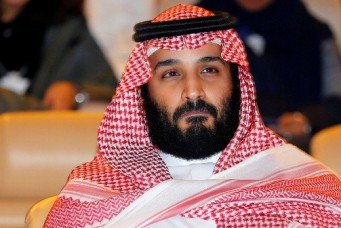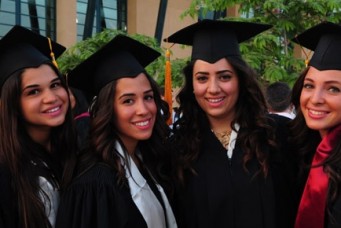The Dream of a City
Will Neom, the Saudi leadership’s new “city of the future,” become a reality?

Visitors watch a 3D presentation during an exhibition on ‘Neom’, a new business and industrial city, in Riyadh, Saudi Arabia, October 25, 2017. Faisal Al Nasser/Reuters
Saudi Arabia’s penchant for mega-projects predates Crown Prince Mohammad Bin Salman’s ascension to power, but he has taken this model further. In the past two years, the prince has announced three mega-projects, including an entertainment city just outside of Riyadh called Qidiyya, a resort complex on the Red Sea called the Red Sea Project and Neom, a planned 10, 200-square-mile city (roughly the size of the state of Rhode Island) in the northwest corner of Saudi Arabia.
The idea of Neom (the name is a combination of the prefix “neo” and the first letter of the Arabic word, mostaqbal, for “future” meaning “New Future”) was announced at the first Future Investment Initiative Conference in Riyadh in October 2017. The plans call for Neom to house biotechnology, entertainment and advanced manufacturing industry. According to Prince Mohammad, the city will run entirely on renewable energy and will rely on robots for most of its mundane functions. He says Neom and the resort city on the Red Sea will exist outside of Saudi Arabia’s judicial and economic bureaucracies, with its own rules and regulations, but it will presumably still come under the reign of the Saudi sovereign.
The actual area of Neom is supposed to incorporate parts of Jordan and Egypt, which has the potential to create a united or international economic zone. People of every faith from every country will be invited—but the Saudi prince has not said whether this will include neighboring Israelis.
Saudi Arabia’s neighbors were initially enthusiastic about the project. Last March, Egypt went so far as to allocate more than 1,000 square kilometers of land in the southern Sinai toward the project as part of a $10 billion economic deal between Cairo and Riyadh. However, there is no indication that any actual development has occurred in Egypt.
Last March, Jordan indicated it was in the process of discussing potential joint investments with Saudi Arabia in Aqaba, but most of the conversation between the two nations has centered on attracting cruise ships to the Jordanian port city. According to reports in the Jerusalem Post, several Israeli companies are holding secret discussions with the Saudi Public Investment Fund (PIF) to potentially operate in Neom, but they would not be able to publicly participate in the city without a political rapprochement between the Saudi and Israeli governments. Israel does have a flourishing technology sector and Israeli expertise would benefit NEOM, but no Israeli company is large enough to be the kind of anchor-tenant needed by a project as large as NEOM. There has been no mention of including the Palestinian Authority in developing the city.
According to Prince Mohammad, Neom, “is not for conventional people or conventional companies.” Rather, it “will be a place for the dreamers of the world.” Yet, a year and a half after its announcement, Neom is still mostly desert. According to some reports, several royal palaces and possibly an airport have been constructed. Expectations must be reasonable, but Saudi Arabia’s recent track record on planned cities should be considered carefully.
Two recent development projects are still largely empty, even though they were advanced before Prince Mohammad’s rise to power. The King Abdullah Financial District, in the center of Riyadh, was designed to be a series of fifty-nine towers. It was intended to house global financial institutions and the Saudi stock exchange. Nearly thirteen years later, the project is only partially completed and most of the office space has not been leased.
Across the country, on the Red Sea coast, sits the King Abdullah Economic City—or at least part of the sixty seven-square-mile city that was proposed in 2005. The plans called for six distinct sectors and a population of two million (in a city the size of Washington, D.C., which has about a third as many people). Right now, only about 7 thousand people live there. Two manufacturers have moved in, but the city is underperforming its economic benchmarks.
Despite past failures, Saudi Arabia’s top leadership continues to forge ahead with plans for its newly announced recreation and industrial megaprojects. According to the Saudi Press Agency, construction of Neom’s residential areas will begin this year and the first phase of the city, which is supposed to include a bridge connecting it to Egypt and the African continent, is scheduled to be completed by 2025. So far, no businesses have announced tenancy in Neom, though in May 2018, the city’s former CEO Klaus Kleinfeld claimed there was a great deal of interest in the city from technology companies.
In July, Kleinfeld was replaced as CEO with Nadhmi Al-Nasr, who was previously an engineer and project manager at ARAMCO—the Saudi national oil company—and interim president of King Abdullah University of Science and Technology (which is located in the King Abdullah Economic City).
Neom seems to be falling prey to the same problems that its predecessor megaprojects faced—much hype and no demand. But it does not have to be that way. The Saudi government can try another business model that it has used before with great success.
In the 1970s, Saudi Arabia commissioned two industrial cities—one to be built on the Red Sea coast and another on the Persian Gulf. The plans called for two sleepy fishing villages, Yanbu and Jubail, to be transformed into industrial ports and centers for petroleum refining and petrochemical manufacturing. Before construction even started, companies like Exxon, Dow Chemical, and Shell had already committed to joint ventures with ARAMCO at these sites. As soon as the infrastructure was set up, the businesses moved in. Today, Yanbu and Jubail account for 12 percent of Saudi Arabia’s GDP.
Yanbu and Jubail succeeded where the King Abdullah Financial District and King Abdullah Economic City have not because they were managed by experienced and capable project managers who had concrete plans for construction and leasing. The cities were oriented toward serving the growing energy and petrochemical industries, and the managers ensured that they had tenants ready to move in even before infrastructure was built.
With this in mind, here is how Prince Mohammad and Al-Nasr can turn Neom into a success and avoid the mistakes of the past: Neom will have a much better chance if it is built to meet demand rather than to inspire it. Neom must also make its business, social, and religious regulations clear in advance. In brief, businesses considering Neom need regulatory certainty.
Instead of focusing on “sixteen sectors” of innovation, Neom should hone these down to industries that Saudi Arabia knows and is known for. Neom project planners should focus on one or more industries in which Saudi Arabia already has native knowledge and experience. Saudi Arabia should partner with international firms that are interested in working in Saudi Arabia, specifically. A great start would be new energy technologies and improving global desalination techniques. Desalination is a field that could pull in expertise and capital from Egypt, Jordan, Israel, and the Palestinian State as all of these nations face the growing need to provide clean water to desert regions. This would promote a more organic and grassroots form of economic cooperation.
Neom should also actively recruit top researchers, scientists, engineers, innovators, and startups with cash resources and the opportunities to design their own labs and innovation hubs. Perhaps, global contests would help identify the right enterprises and would generate prestige and excitement.
Prince Mohammad generated a great deal of hype when he announced Neom in October 2017, but in order to make Neom a reality, Saudi Arabia should look to the methods that led to the successful industrial cities of Yanbu and Jubail, as the kingdom works to diversify its economy.
Ellen R. Wald is an energy historian and the president of Transversal Consulting. She is also a nonresident senior fellow at the Atlantic Council’s Global Energy Center. She writes weekly columns for Investing.com, Forbes and





